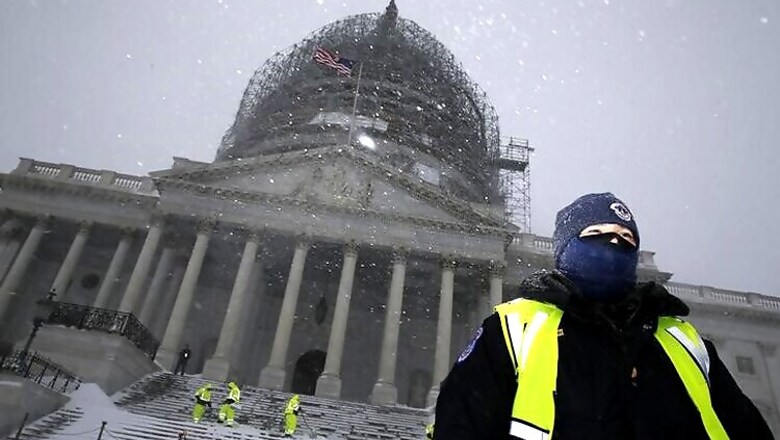
views
New York/Washington: New York lifted a travel ban and mass transit started getting back to normal on Sunday after a near-record blizzard in the US Northeast, but Washington remained at a standstill following storms that killed at least 19 people across the country.
The storm was the second-biggest in New York City history, with 26.8 inches (68 cm) of snow in Central Park by midnight on Saturday, just shy of the record 26.9 inches (68 cm) set in 2006, the National Weather Service said.
Thirteen people were killed in weather-related car crashes in Arkansas, North Carolina, Kentucky, Ohio, Tennessee and Virginia on Saturday. One person died in Maryland and three in New York while shoveling snow. Two died of hypothermia in Virginia, officials said.
New York Mayor Bill de Blasio said on Sunday would be a major cleanup day. He urged residents to stay off streets so city crews could clear roads.
"We still have some areas that we have to do a lot more work on. But we've come through it pretty well," he said on ABC's "This Week with George Stephanopolous."
"The snow pile is going to be with us for a while, but I think we'll be in good shape in the next 24 hours," de Blasio said.
After the storm moved out into the Atlantic Ocean, much of the Northeast was expected to see a mix of sun and clouds on Sunday with temperatures just above freezing.
New York state Governor Andrew Cuomo lifted a travel ban on New York City-area roads and on Long Island at 7 am (1200 GMT) on Sunday. A state of emergency declared by Cuomo was still in place.
Most bus and subway services operated by the Metropolitan Transportation Authority were up and running again by 9 am (1400 GMT), officials said, and the agency was working on restoring full service on Sunday.
The Metro-North rail line, which serves suburbs north and east of New York City, expected to have commuter train service running into and out of New York by 3 pm (2000 GMT) on Sunday. A spokeswoman for the New York Stock Exchange said the market planned to open as usual on Monday.
RECORDS SET
The National Weather Service said 17.8 inches (45.2 cm) fell in Washington, a tie with the fourth-largest snowfall in the US capital's history. Baltimore-Washington International Airport notched a record 29.2 inches (74.2 cm); the deepest regional total was 42 inches (106.7 cm) at Glengarry, West Virginia.
Washington was a dazzling white under a bright sun, and some people, including the occasional cross-country skier, were out in the wintry landscape on Sunday.
Mayor Muriel Bowser issued a call for 4,000 people to help dig the city out, above the 2,000 volunteers already signed up.
The Washington Metropolitan Area Transit Authority, which includes the United States' second-busiest subway system, had suspended operations through Sunday. Officials said public schools would be closed in Baltimore and Washington on Monday.
One Washington food store, Broad Branch Market, opened with a handful of employees, and was trying to organize volunteers to shovel the sidewalks of the elderly and others who needed help.
“We do a snow brigade every time it snows. I have a lot of people on the list (who want shoveling) but I have yet to have any kids sign up to work today,” said the owner, Tracy Stannard.
The market is out of firewood, snowmelt chemical and bread - but is baking baguettes, she said.
At Dupont Circle, hundreds of people gathered to pelt each other with snowballs, a local tradition. Jomel Nichols, a tourist from Kansas City, Missouri, accompanying three exchange students and her daughter, was plastered with snow.
"They all turned on me, as teenagers will do," she said.
FLIGHTS CANCELED
About 3,750 flights were canceled on Sunday, and 700 were canceled for Monday, according to FlightAware.com, an aviation data and tracking website.
In New York, flights had begun landing again at John F. Kennedy International Airport and would soon start taking off from there, Cuomo told a news conference.
United Airlines said it would not operate at Washington-area airports on Sunday, and would gradually resume service on Monday.
About 150,000 customers in North Carolina and 90,000 in New Jersey lost electricity during the storm.
More than 20,000 residential and business customers in New Jersey remained without power on Sunday, mostly along the Jersey Shore, which was hit with major flooding. In and around Cape May, 9,000 customers alone were affected by power outages, according to the Atlantic City Energy utility.
In North Carolina, about 4,000 Duke Energy customers had no power on Sunday, mostly in the eastern part of the state.
On Sunday, moderate coastal flooding was still a concern in the Jersey Shore's Atlantic County, but a change of wind direction would make the impact less of a problem than on Saturday, said Linda Gilmore, a county public information officer.
The storm developed along the Gulf Coast when warm, moist air from the Atlantic Ocean collided with cold air to form the massive winter system, meteorologists said.



















Comments
0 comment